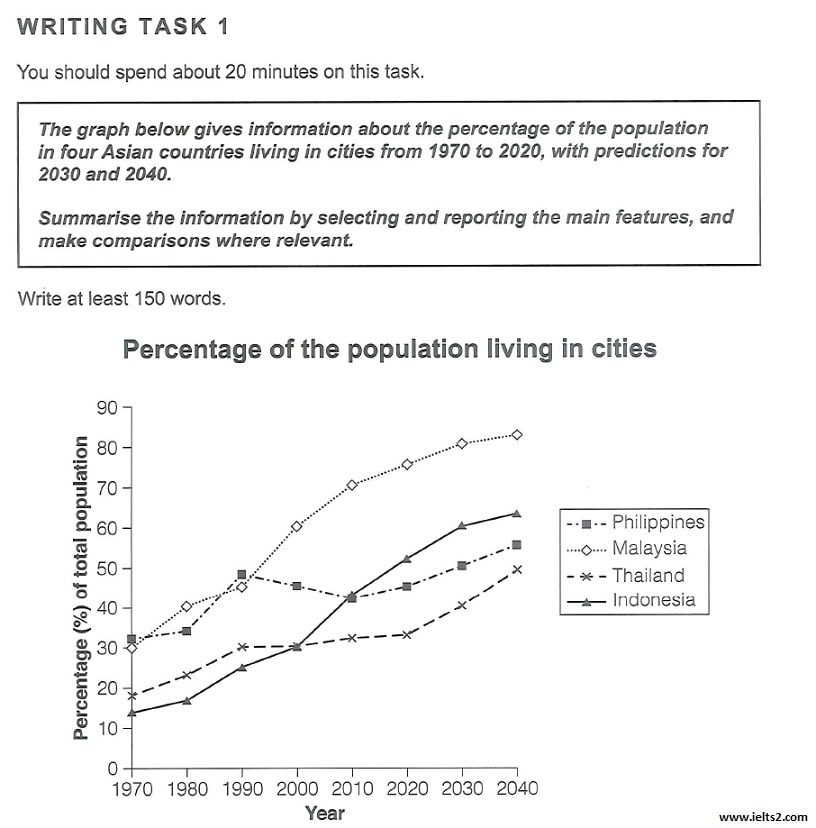رایتینگ نمودار خطی کمبریج آیلتس جلد 18 آکادمیک تست 1
Cambridge IELTS Academic 18 Test 1 Task 1 Line Graph Band 9
در اینجا یک نمودار خطی از تست 1 جلد 18 سری کتاب های کمبریج آیلتس آکادمیک را همراه با جواب نمره 8 تا 9 با هم میبینیم. این رایتینگ از انواع Line Graph می باشد و پاسخگویی به آن نیازمند شناسایی و دسته بندی اطلاعات اصلی یا Main Feature ها در نمودار و گزارش آن ها در 4 پاراگراف (مقدمه و جمع بندی و 2 پاراگراف توضیحات اصلی) است. بعد از ارایه نمونه نمره 8 برای این نمودار، تحلیل و آنالیز گرامر و لغات آکادمیک همین سمپل را خواهیم داشت. اگر با این بخش از رایتینگ نویسی آیلتس آکادمیک آشنایی ندارید، انواع 7 نوع سوال در تسک 1 رایتینگ آیلتس آکادمیک پیشنهاد بعدی ما به شما عزیزان است.
سوال رایتینگ نمودار خطی کمبریج 18 تست 1 (Line Graph)

متن سوال نمودار خطی کمبریج 18 تست 1 (Line Graph)
The graph below gives information about the percentage of the population in four Asian countries living in cities from 1970 to 2020, with predictions for 2030 and 2040.
Summarise the information by selecting and reporting the main features, and make comparisons where relevant.
نمونه پاسخ نمره 9:
The line graph illustrates the proportion of people living in urban areas across four Asian countries from 1970 to 2020, along with projections for 2030 and 2040.
Overall, all four countries experienced an upward trend in the percentage of city dwellers, with Malaysia consistently having the highest proportion. This trend is expected to continue in the coming decades.
In 1970, both Malaysia and the Philippines had approximately 30% of their populations residing in cities. Malaysia saw significant growth, with around 75% of its population living in urban areas by 2020. In contrast, the Philippines saw more fluctuation, with its urban population varying between 35% and 45% over the period.
In 1970, Thailand’s urban population stood at nearly 20%, while Indonesia had a slightly lower percentage of 15%. However, Indonesia’s urban population grew more rapidly, reaching close to 50% by 2020, whereas Thailand’s urbanization rate increased to around 30%.
Looking ahead, the projections suggest continued growth in urban populations across all four countries. By 2040, Malaysia is forecast to have the highest urban population, surpassing 80%, followed by Indonesia at around 65%. The Philippines and Thailand are expected to see urbanization rates of about 55% and 50%, respectively.
Total = 197 words
لغات و ساختارهای گرامری پیشرفته به کار رفته:
گرامر یکی از 4 بخش اصلی در جدول نمره دهی رایتینگ آیلتس در تسک 1 است. در این بخش نگاهی به ساختارهای دستوری پیشرفته این سمپل نمره 9 داریم. همچنین در بخش بعدی همین مطلب به فرمت 4 پاراگرافی این نمونه رایتینگ نگاهی دقیق تر خواهیم داشت.
- Comparison and Contrast:
- Example: “Malaysia saw significant growth, with around 75% of its population living in urban areas by 2020. In contrast, the Philippines saw more fluctuation.”
- Explanation: The contrast between the countries is highlighted using comparative structures like “saw significant growth” and “saw more fluctuation.” This is essential in Task 1 to effectively compare data trends.
- Use of Projections:
- Example: “Predictions indicate further growth in the population living in cities across all four countries.”
- Explanation: The use of the verb “indicate” and “predictions” introduces the projected data for future years. This kind of structure is used to predict future trends based on the data given, which is typical in Task 1 when there are future projections.
- Verb Tenses:
- Past Simple: “Malaysia saw significant growth,” “Thailand’s urban population stood at nearly 20%.”
- Explanation: The past tense is used to describe historical data from the graph. It is necessary to maintain consistency when describing trends over time.
- Future Simple: “By 2040, Malaysia is forecast to have the highest urban population.”
- Explanation: Future tenses (“is forecast to” and “will likely”) are employed to express the projected changes, indicating a clear understanding of future trends.
- Use of Precise Data:
- Example: “Malaysia had approximately 30% of its population residing in cities in 1970,” “Thailand’s urban population stood at nearly 20%.”
- Explanation: Precise numerical data is essential in Task 1 to convey exact information. The use of terms like “approximately” and “nearly” helps provide accuracy without being overly specific, maintaining a formal tone.
- Complex Sentences:
- Example: “In contrast, the Philippines saw more fluctuation, with its urban population varying between 35% and 45% over the period.”
- Explanation: The sentence structure here is complex, with a dependent clause (“with its urban population varying between 35% and 45%”) providing additional detail. The use of complex sentences increases the level of sophistication in writing.
فرمت رایتینگ تسک 1 برای نمره کامل:
- Introduction:
- Purpose: The introduction should paraphrase the task statement, providing a clear overview of what the graph represents.
- Example: “The line graph illustrates the proportion of people living in urban areas across four Asian countries from 1970 to 2020, along with projections for 2030 and 2040.”
- Overview:
- Purpose: Summarize the key trends and patterns in the data. The overview should highlight the main changes without going into too much detail.
- Example: “Overall, all four countries experienced an upward trend in the percentage of city dwellers, with Malaysia consistently having the highest proportion.”
- Body Paragraphs:
- Purpose: The body should describe the details of the graph, breaking down the information for each country and year. It’s essential to present this data logically, typically by grouping countries with similar trends or focusing on one country at a time.
- Example: “In 1970, both Malaysia and the Philippines had approximately 30% of their populations residing in cities. Malaysia saw significant growth, with around 75% of its population living in urban areas by 2020.”
- Cohesion and Coherence:
- Purpose: Use cohesive devices (e.g., “in contrast,” “meanwhile,” “by 2020”) to ensure that the information flows logically between paragraphs and sentences.
- Example: “In contrast, the Philippines saw more fluctuation, with its urban population varying between 35% and 45%.”
- Formal Tone:
- Purpose: Maintain a formal tone throughout the description. Avoid using subjective language or personal opinions.
- Example: “Looking ahead, the projections suggest continued growth in urban populations across all four countries.”
- Precise and Accurate Reporting:
- Purpose: Report the data accurately, providing exact figures and comparisons where necessary. Use numbers and percentages to give a clear picture of the trends.
- Example: “By 2040, Malaysia is forecast to have the highest urban population, surpassing 80%, followed by Indonesia at around 65%.”
نمونه های بیشتر و تصحیح رایگان رایتینگ شما ❤️
100 نمونه رایتینگ آیلتس پیشنهاد آخر ما به دوستان گرامی هست. این نمونه رایتینگ های تسک 1 آیلتس از پرتکرار ترین نوع سوالات این بخش و همچنین جدیدترین موضوعات می باشند. این مجموعه توسط یکی از سایت های معتبر انگلیسی زبان فعال در حوزه آیلتس تنظیم شده است. همچنین برای تصحیح رایگان رایتینگ آیلتس تسک 1 و 2 به صورت نامحدود در کانال تلگرام رایتینگ ما همراه باشید و به ادمین برای تصحیح رایتینگ اطلاع دهید.






